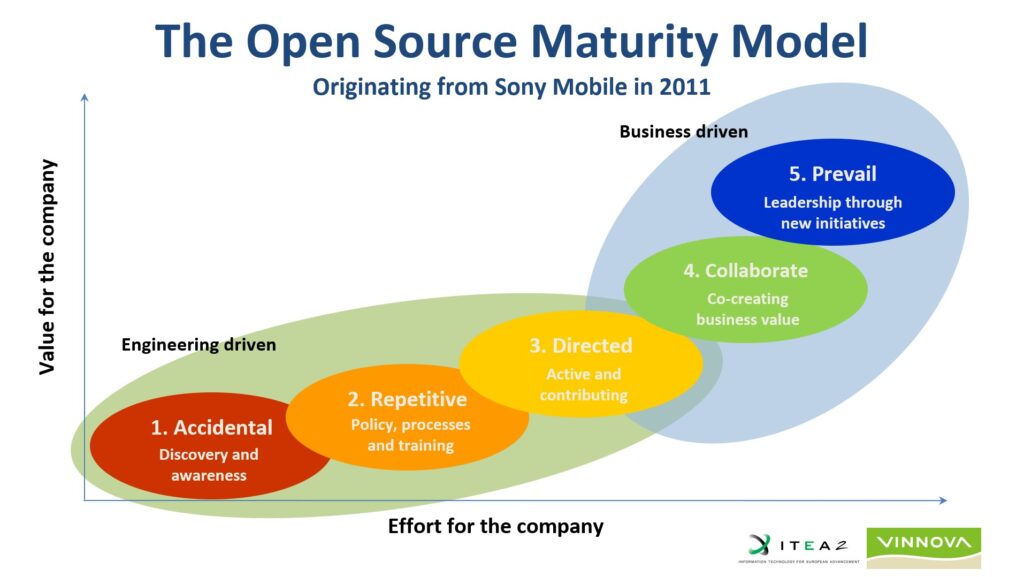Open source strategist Carl-Eric Mols on the role open source will play in achieving Software-Defined Vehicles. In this interview he reflects on his experiences from Sony Mobile with the rise of Linux and Android in mobile phones. Learn why the open source way is absolutely key to unlock compute power and accelerate new collaborations in automotive.
Back in the early 2000’s, I saw from my role at Sony Mobile the mechanisms of open source and how it can disrupt markets. We knew Linux would end up in mobile phones and it happened with Android. Sony Mobile was the fourth largest player on the market, but it became impossible to compete with an internally developed solution with the collaborative force of something that was co-developed by thousands of people. During the past decades, open source has established itself as a standard operating practice building industry wide collaboration platforms where all participants share the development, the efforts, the standards & also the goals for what the system should become. I’m basically seeing history repeat itself, with the same mechanisms and needs now happening in the automotive industry.
I’m a firm believer that open source is the only possible way to establish a collaboration amongst all the automotive companies. Further, I think it is safe to say that no modern software development is done in any industry today without building on open source. Open source is a beneficial way to collaborate, not only between giants but with all players including smaller specialized companies solving specific challenges efficiently. If a new technology is good and several players adopt it – open source can establish it like a de facto standard.Today in automotive, a lot of the innovative collaborations happen in silos. But any silo collaborations with potential will amplify faster in an open source culture. A handful of fairly new cluster organisations are growing in significance in automotive – COVESA, Eclipse Foundation, SOAFEE and Automotive Grade Linux to name the key ones. We see that the OEMs are giving them recognition by joining, which in turn will create more bilateral collaborations, accelerate development and create the much-needed de facto standards.
Simply put – because the amount of software needed in a vehicle is exploding. In Volvo Cars, the amount of software is 10 times the amount compared to 7 years ago. No single company can carry the cost, attract the developers, and produce the required code themselves. As proven by other industries, open source is the way to go. Part of the software will still be proprietary for edge and brand. A quick look into the mobile industry again shows that 87% of the code in a Sony Mobile would be untouched Android code, around 8% would be modified for adoptions to operators or market needs – remaining 5% was Sony Mobile own developed code for differentiation, market value and abilities of the product.
Similarly in automotive, the plumbing, most of the code in a vehicle that is necessary, but not the differentiator, could be open source. The change will probably take longer than in telecom, where it took 3-5 years. Automotive OEMs should get used to the idea that with the open source way, your biggest competitors become your most important partners.
During my time at Sony Mobile, we developed a model with five distinct phases that an organization has to go through to mature open source usage. The three first phases are engineering driven, but it is level four and five that holds the large market opportunities.

In automotive, I’m quite sure we will see something close to level four with some automakers collaborating on shared platforms while competing with the differentiating part of the software.
The lack of common standards:
The telecom industry had standards since the first telegraph to be able to call between countries. In automotive, everyone has been creating their own standards, which is a hinder for open source. In open source, we have a solution for it though as we talk about de facto standards that often have beaten the standard-setting organizations historically.
Functional safety:
Safety is a good solid reason for the very proprietary, traditional embedded world that automotive is. Open source is not unsafe, but it has not been designed to be put into a vehicle that runs on a highway and the safety implications it brings. However, we see a clear tendency already for finding ways to make it work – for example extending safety standards with how to introduce pre-existing software into safety applications.
The outdated toolchains:
It is clear that software developers in automotive are longing for the well-established tools other industries are using like cloud native development, testing and verification of your car software in the cloud etc. Here I am positive that the culture that comes with open source also will become a market tool and business disruptor to crush outdated monopolies. If you do things proprietary and locked-in, you have a hard way competing in a collaborative landscape driven by a strong open source community.
The complex landscape:
Automotive has 120-130 years of legacy and were competing with our own standards in a complex structure of supply chains. With huge software systems and increased demand for compute powers, it all suggests moving to open source to cope. But as there is no big player that can take the role Android took in telecom, the cluster organizations will be critical, but it will take time. However, the emerging Chinese automotive brands and their speed in adopting open source does put pressure on all the other players to accelerate new practices.
Volvo Cars has been a customer of RemotiveLabs since 2020 and is actively using their toolchain in software prototyping, development and testing.
Volvo Cars Tech Fund is an investor in RemotiveLabs since 2022.
Volvo Cars and RemotiveLabs collaborates in open standard organization COVESA, recently by presenting for example how Volvo Cars advance their Android development using innovative tooling’s such as RemotiveLabs.